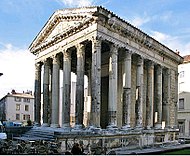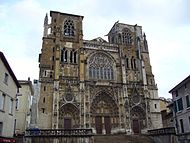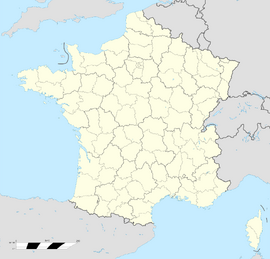| Vienne | |
|---|---|
|
|
|
| Coordinates: Coordinates: | |
| Country | France |
| Region | Auvergne-Rhône-Alpes |
| Department | Isère |
| Arrondissement | Vienne |
| Intercommunality | Pays Viennois |
| Government | |
| • Mayor | Jacques Remiller |
| Area1 | 22.65 km2 (8.75 sq mi) |
| Population (1999)2 | 29,975 |
| • Density | 1,300/km2 (3,400/sq mi) |
| INSEE/Postal code | 38544 / 38200 |
| 1 French Land Register data, which excludes lakes, ponds, glaciers > 1 km² (0.386 sq mi or 247 acres) and river estuaries. 2 Population without double counting: residents of multiple communes (e.g., students and military personnel) only counted once. | |
Vienne is a commune in south-eastern France, located 20 miles (32 km) south of Lyon, on the Rhône River. It is the second largest city after Grenoble in the Isère department, of which it is a subprefecture. The city's population was of 29,400 as of the 2001 census.
Before the arrival of the Roman armies, Vienne was the capital city of the Allobroges, a Gaul people. Transformed into a Roman colony in 47 BC under Julius Caesar, Vienne became a major urban center, ideally located along the Rhône river, then a major axis of communication. The town later became a Roman provincial capital. Numerous remains of Roman constructions are still visible in modern Vienne. The town was also an important early bishopric in Christian Gaul. Its most famous bishop was Avitus of Vienne. At the Council of Vienne, convened there in October 1311, Pope Clement V abolished the order of the Knights Templar. During the middle ages, Vienne was part of the kingdom of Provence, dependent on the Holy Roman Empire, while the opposite bank of the Rhône was French territory thus making it a strategic position.
Today, the town is a regional commercial and industrial center specializing in the food industry. Tourism is also a major part of the town's economy. Indeed, there are many important historical monuments that draw the crowds, but the annual jazz festival (July) also makes it a popular tourist destination.
History[]
Roman Vienne[]

Roman Temple (Temple d'Auguste et de Livie)
The oppidum of the Allobroges became a Roman colony about 47 BC under Julius Caesar, but the Allobroges managed to expel them: the exiles then founded the colony of Lugdunum (today's Lyon). Herod Archelaus was exiled here in 6 AD. Under the early Empire Vienna (as the Romans called it—not to be confused with today's Vienna [German Wien], which the Romans called Vindobona) regained all its former privileges as a Roman colony. In 257 Postumus was proclaimed emperor here of a short-lived Gallo-Roman empire with its capital at Trier. Later it became a provincial capital of the Dioecesis Viennensis.
On the bank of the Gère are traces of the ramparts of the old Roman city, and on Mont Pipet (east of the town) are the remains of a Roman theatre, while the ruined thirteenth century castle there was built on Roman footings. Several ancient aqueducts and traces of Roman roads can still be seen.
Two Roman monuments at Vienne are outstanding. One is the Early Imperial temple of Augustus and Livia, a rectangular peripteral building of the Corinthian order, erected by the emperor Claudius, which owes its survival, like the Maison Carrée at Nîmes, to being converted to a church soon after the Theodosian decrees and later rededicated as "Notre Dame de Vie." In it the local Festival of Reason was held during the Revolutionary Reign of Terror. The other is the Plan de l'Aiguille, a truncated pyramid resting on a portico with four arches, from the Roman circus. Many popular theories have been advanced as to what this structure was originally intended for, and there is even a legend of Pontius Pilate making it his tomb.
Christian Vienne[]
The provincial capital was an important early seat of a bishop, the legendary first bishop said to have been Crescens, a disciple of Paul. Certainly there were Christians here in 177 when the churches of Vienne and Lyon addressed a letter to those of Asia and Phrygia and mention is made of the deacon of Vienne (Eusebius of Caesarea, Church History). The first historical bishop was Verus, who was present at the Council of Arles in 314. About 450 of Vienne's bishops became archbishops (dissolved in 1790) and its archbishops disputed with those of Lyon the title of "Primate of All the Gauls".

The ruins of Vienne's Medieval castle

Saint-Maurice Cathedral
Vienne was an unfortunate target during the Migrations Period: taken by the Burgundians in 438, re-taken by the Romans and held for 35 years, by the Franks in 534, sacked by the Lombards in 558 and by the Moors in 737.
Capital of ancient Burgundy[]
According to historien Pline, Vienne was set up as the capital for Burgundy by Gondioc, king of Burgundians.
In the Kingdom of Provence[]
King Charles II the Bald assigned the district in 869 to Count Boso of Provence, who in 879 proclaimed himself king of Provence and was buried on his death in 887 in the cathedral church of St Maurice. Vienne then continued to form part of the kingdom of Provence and then of Arles until in 1032 when it reverted to the Holy Roman Empire, but the real rulers were the archbishops of Vienne. Their rights were repeatedly recognized, but they had serious local rivals in the counts of Albon, and later Dauphins of the neighboring countship of the Viennois. In 1349, the reigning Dauphin sold his rights to the Dauphiné of France, but the archbishop stood firm and Vienne was not included in this sale. The archbishops finally surrendered their territorial powers to France in 1449. Gui de Bourgogne, who was archbishop 1090–1119, was pope from 1119 to 1124 as Callixtus II.
Main sights[]
The early Romanesque church of Saint Peter belonged to an ancient Benedictine abbey and was rebuilt in the ninth century with tall square piers and two ranges of windows in the tall aisles and a notable porch. It is one of France's oldest Christian buildings dating from the 5th century laid-out in the form of a basilica and having a large and well constructed nave. It also boasts a beautiful Romanesque tower and a magnificently sculptured South portal containing a splendid statue of Saint Peter. Today, the building houses a lapidary museum which holds a Junon head and the beautiful Tutela Statue, the city's protective divinity.
The Gothic former cathedral of St Maurice was built in many campaigns over a long period, between 1052 and 1533. It is a basilica, with three aisles, but no apse or transepts. It is 315 ft. in length, 118 ft. wide and 89 in height. The most striking portion is the west front, which rises majestically from a terrace overhanging the Rhône. But the sculpural decoration was badly damaged by the Protestants in 1562, during the Wars of Religion. [Vienne Cathedral:[1],[2]

Vienne's city hall

Vienne's Roman Pyramid at night
The Romanesque church of St André en Bas was the church of a second Benedictine monastery, and became the chapel of the earlier kings of Provence. It was rebuilt in 1152, in the later Romanesque style.
Twin cities[]
- Albacete, Spain
 - Esslingen, Germany
- Esslingen, Germany- Goris, Armenia
- Neath Port Talbot, United Kingdom
- Piotrków Trybunalski, Poland
- Schiedam, Netherlands
- Udine, Italy
- Velenje, Slovenia
- Greenwich, Connecticut, United States
See also[]
- Archbishopric of Vienne
Sources and references[]
- This article incorporates text from the Encyclopædia Britannica Eleventh Edition, a publication now in the public domain.
This article incorporates text from a publication now in the public domain: Herbermann, Charles, ed (1913). Catholic Encyclopedia. Robert Appleton Company.
External links[]
- Official website (in French)
- Tourist information
- Vienne Photogallery
- Livius.org: Roman Vienne - pictures
- Official site of the Festival de jazz à Vienne
Template:Isère communes
| This page uses content from the English language Wikipedia. The original content was at Vienne, Isère. The list of authors can be seen in the page history. As with this Familypedia wiki, the content of Wikipedia is available under the Creative Commons License. |


